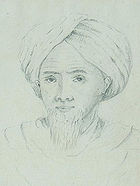
Tuanku Imam Bonjol
Encyclopedia

Indonesia
Indonesia , officially the Republic of Indonesia , is a country in Southeast Asia and Oceania. Indonesia is an archipelago comprising approximately 13,000 islands. It has 33 provinces with over 238 million people, and is the world's fourth most populous country. Indonesia is a republic, with an...
n struggle against Dutch
Netherlands
The Netherlands is a constituent country of the Kingdom of the Netherlands, located mainly in North-West Europe and with several islands in the Caribbean. Mainland Netherlands borders the North Sea to the north and west, Belgium to the south, and Germany to the east, and shares maritime borders...
rule. He was born in the village of Tanjung Bunga in the Pasaman
Pasaman
Pasaman is a regency of West Sumatra, Indonesia. It has an area of 3,947.63 km² and a population of approximately 243,000 people. The capital is Lubuk Sikaping....
regency of West Sumatra
West Sumatra
West Sumatra is a province of Indonesia. It lies on the west coast of the island Sumatra. It borders the provinces of North Sumatra to the north, Riau and Jambi to the east, and Bengkulu to the southeast. It includes the Mentawai Islands off the coast...
. His father's name was Buya Nudin. He was immersed in Islam
Islam
Islam . The most common are and . : Arabic pronunciation varies regionally. The first vowel ranges from ~~. The second vowel ranges from ~~~...
ic studies as he grew up, studying first from his father and later under various other Muslim theologians.
After founding the state of Bonjol
Bonjol
Bonjol is name of a subdistrict in the Pasaman regency , province West Sumatera, Indonesia. It is famous especially for its location as it lies just at the equator line...
, Syarif became involved in the Adat
Adat
Adat in Indonesian-Malay culture is the set of cultural norms, values, customs and practices found among specific ethnic groups in Indonesia, the southern Philippines and Malaysia...
/Paderi controversy as a Paderi leader. The Paderi movement, which has been compared to the Ahlus Sunnah wal Jamaah (Sunni) school of Islam in Saudi Arabia
Saudi Arabia
The Kingdom of Saudi Arabia , commonly known in British English as Saudi Arabia and in Arabic as as-Sa‘ūdiyyah , is the largest state in Western Asia by land area, constituting the bulk of the Arabian Peninsula, and the second-largest in the Arab World...
, was an effort to return the Islam of the area to the purity of its roots by removing local distortions like gambling, cockfighting, the use of opium and strong drink, tobacco, and so forth. It also opposed the powerful role of women in the matrilineal Minangkabau culture. The Adat, or traditionalist, position was that local custom that pre-dated the arrival of Islam should also be respected and followed.
Feeling their leadership position threatened, the traditionalists appealed to the Dutch for help in their struggle against the Paderis. At first, the Dutch were not able to win militarily against the Paderis because their resources were stretched thin by the Diponegoro
Diponegoro
Diponegoro , also known as Dipanegara, was a Javanese prince who opposed the Dutch colonial rule. He played an important role in the Java War...
resistance in Java. In 1824, the Dutch signed the Masang Agreement ending hostilities with the state of Bonjol.
Subsequently, however, once the Diponegoro resistance was suppressed, the Dutch attacked the state of Pandai Sikat in a renewed effort to gain control of West Sumatra. Despite valiant fighting by the Indonesians (by this time the traditionalists had realized they didn't want to be ruled by the Dutch either and had joined forces with the Paderis in their resistance), the overwhelming power of the Dutch military eventually prevailed. Syarif was captured in 1832 but escaped after three months to continue the struggle from his tiny fortress in Bonjol.
After three years of siege, the Dutch finally managed to sack Bonjol on August 16, 1837. Through a negotiation ruse, the Dutch again captured Syarif and exiled him, first to Cianjur
Cianjur
Cianjur is a city in the West Java province of Indonesia, the capital of Cianjur Regency. Cianjur is located in the middle of the main road between Jakarta and Bandung . The population is about 146,874...
in West Java, then to Ambon
Ambon Island
Ambon Island is part of the Maluku Islands of Indonesia. The island has an area of , and is mountainous, well watered, and fertile. Ambon Island consists of 2 territories: The main city and seaport is Ambon , which is also the capital of Maluku province and Maluku Tengah Ambon Island is part of the...
, and later to Manado
Manado
Manado is the capital of the North Sulawesi province of Indonesia. Manado is located at the Bay of Manado, and is surrounded by a mountainous area. The city has about 405,715 inhabitants, making it the second-largest city in Sulawesi after Makassar...
in Sulawesi
Sulawesi
Sulawesi is one of the four larger Sunda Islands of Indonesia and is situated between Borneo and the Maluku Islands. In Indonesia, only Sumatra, Borneo, and Papua are larger in territory, and only Java and Sumatra have larger Indonesian populations.- Etymology :The Portuguese were the first to...
. He died on November 6, 1864, at the age of 92 and is buried in Sulawesi. The site of his grave is marked by a Minangkabau (West Sumatran) house.

